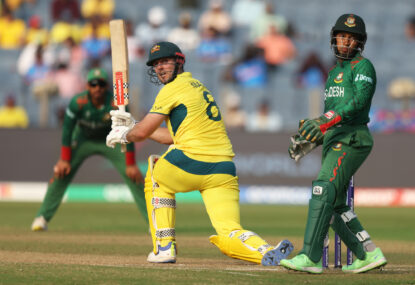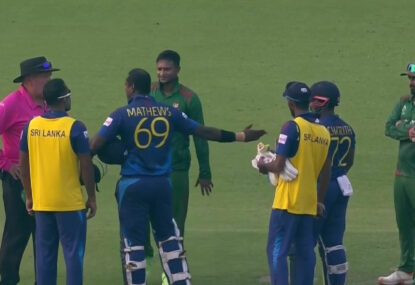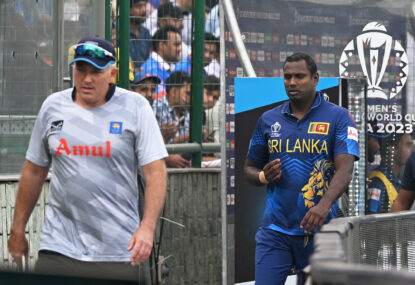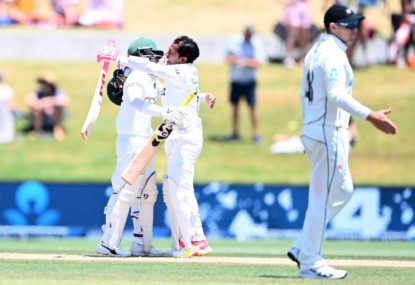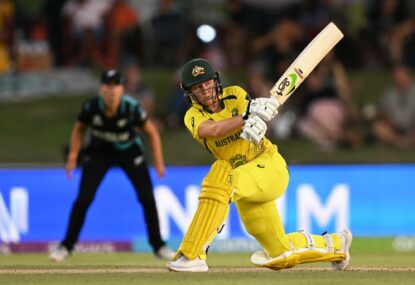The Dacca Stadium, now known as the Bangabandhu National Stadium, started its journey by hosting the four-day Test match between India and Pakistan starting on the new year’s day of 1955.
This was the first ever home Test for Pakistan. The four-day match ended in a draw, although a fifth-day possibly would have seen a result. Chasing 269 for victory, the Indians finished on 2-147.
Until East Pakistan emerged as the new independent nation of Bangladesh in 1971, Dacca was a regular Test venue. In 1958-59 the Pakistanis triumphed in a low-scoring match against the West Indies, as Fazal Mahmood took 12 wickets. But a year later Richie Benaud’s Australians were too strong, and won by eight wickets. Benuad himself performed superbly with the ball and Neil Harvey held the batting together.
While Tests were attended greatly by the Dacca crowd, their biggest passion was football, especially the Aga Khan Gold Cup tournament, an international club competition among the teams from Asia. It was a hugely popular event. I still remember my uncles and many others talking about the 1960 final, when the Calcutta Mohammedans defeated an Indonesian team in an exciting match.
After independence, this ground was basically used for football purposes. The outer stadium, just adjacent to the Dacca Stadium, was allocated to cricket. At that time, it was just a field with no gallery. Now it has developed into a nice little stadium.
In the early ’80s, Dhanmondi Stadium (known more commonly as Abahani Ground) became the main venue for club cricket.
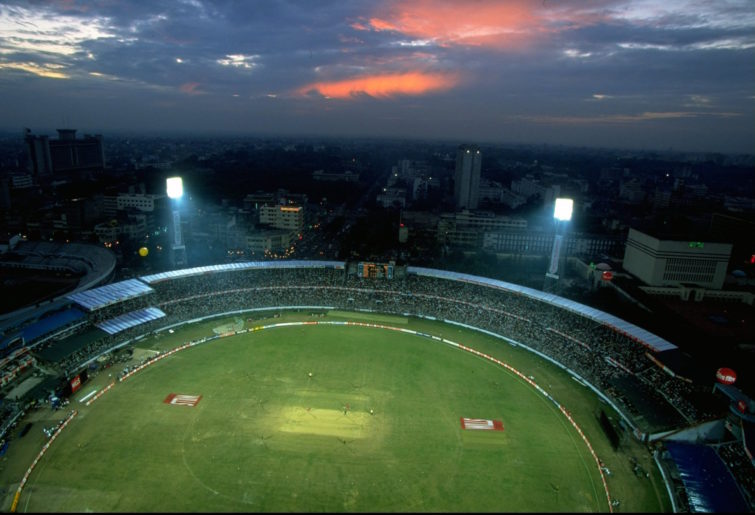
(Photo credit: Stu Forster/Allsport)
I must add that at that time cricket was pretty much a minor sport in the country.
However, things started to change as the MCC team toured Bangladesh in 1976-77. Bangladesh had asked for ICC membership in the summer of 1976. But rather than granting them membership, an MCC team was sent to observe the cricketing facility as well as the cricketing standards.
So Dacca Stadium was allocated for the biggest event of the tour: the three-day unofficial Test between the MCC and the Bangladesh team. This remained the pattern until the mid-1980s. Dacca Stadium was mainly a football stadium, but international cricket matches was held there.
I will start my memories with that historic match in January 1977.
The introduction: MCC versus Bangladesh, January 1977
I fell in love at the age of seven, and it was a deep love destined to last for decades. I fell in love of the game of cricket.
The three-day match started on Friday the seventh. Since 1982, Friday is the weekly holiday in Bangladesh. In those days, Sunday was the holiday with Saturday a half holiday. So on the second day, my dad drove home from his office in Motijheel, had a quick lunch, and then took me to the ground. On the way, he told me the basic rules of the game.
We reached play just before the tea break, and maybe I was a lucky charm. Just as we took our seats in the western gallery, an MCC batsman was out. From the radio we learnt the name of the batsman was Duff. From the website, I now know that he was Alan Duff, a leg-spinner who had a short first-class career mostly playing for Oxford University. He was almost 40 at the time.
We were there the next morning again for the final day, as I continued to enhance my knowledge of the cricket rules. Early in the day, the MCC team crossed the Bangladesh first-innings score of 266, and after that they went for quick runs to build their lead. There were lots of quick singles plus a few desperate dives.
Meanwhile, my dad and the other spectators got excited about something else. A local newspaper had offered a prize of 1000 Bangladeshi taka for the batsman who played the biggest innings of the match. That was quite a big amount in those days. Yousuf Rahman Babu, an all-rounder, had scored 78 in the Bangladesh innings. On the final day, Michael Mence, the left-handed batsman and ex-Warwickshire player was coming close to that score.
Of course, we all wanted Yousuf to win it, and at the end the MCC team were 347 all out with Mence 75 not out.
Then I saw an interesting passage of play. With no chance of a defeat, the MCC men went for all out attack. I still remember big Martin Vernon charging in from the Paltan or northern end of the ground with four slips, a gully and two short legs surrounding the batsman. Facing him was Raqibul Hasan, barely five and a half feet all. Technically, he was the best batsman in the team, but he failed on this day. The middle order, however, performed admirably to save the match.
So it was a great learning day for me. My only regret was that Syed Ashraful, who would soon become my first cricketing idol, was out for a first-ball duck.
The Mark Nicholas day: MCC versus Bangladesh, January 1981
During the final years of the ’70s, I was a frequent visitor to the Dacca Stadium to watch football games with my dad. We returned to watch cricket during the 1980-81 season. I was there for the second day of the three-day match.
The first day was a poor one for the local side. They were bundled out for only 143 despite a patient half century from Raqibul. To make matters worse, Jahangir Badshah – our premier fast bowler – left the field late on the day with a muscle pull. He played no further part in the match.
However, we were quite optimistic about our chances. Our attack was mainly built around our spinners, and the MCC batsmen had struggled against them in the previous matches of the tour.
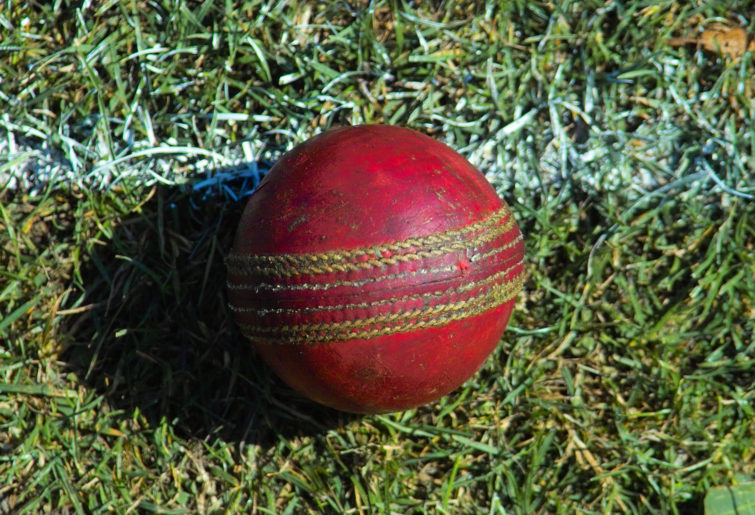
(Wiki Creative Commons, CC BY-SA 3.0)
There was Azhar, the tall off-spinner, fresh from a six-wicket haul in the previous match. Khaled Rumy was the leg-spinner, plus there was my hero Ashraful.
But we were disappointed. Our bowling made little impression on the MCC batting, especially on their number three Mark Nicholas. The Hampshire batsman had struggled for runs on this tour and was very cautious before lunch. As the mid afternoon sun shone brightly, he started to show his stroke-making ability more fully.
And he cut loose after completing his hundred, eventually finishing with 147 not out. Towards the end, he was given company by Richard Hutton, the son of Sir Len Hutton. The younger Hutton completed a quick 50, lofting a hapless looking Ashraful for three consecutive sixes. My hero was past his best and retired after the next season.
As for Nicholas, he became the first Englishmen since Basil D’Oliveira (1969) to score a ton at this venue. Also, his 147 not out remained the highest score in an international match in our independent days on this ground until 1986, when the Indian Test player Arun Lal, playing for the West Bengal team, would better it.
The one-day match: Bangladesh versus West Bengal, March 1983
We were a bit late in attending the match. Accustomed to 10am starts, we left our home a bit late. Just as we entered the Paltan area, adjacent to the stadium, we heard a loud noise coming from the stadium. Over the radio, we learnt that Palash Nandy, the WB opener, was run out.
More noises meant more successes. And just as we took our seats, Badshah, the ever-present medium pacer in our team, bowled Prabir Chel. It became 4-45. The crowd was excited. The underdogs were on top.
Opener Pranab Roy was still there in the middle. Now, most of the international matches played by Bangladesh at home during the era were exhibition matches. All the teams touring Bangladesh at the time – the MCC, the Sri Lankan national team, the Deccan Blues (from India) and PIA (from Pakistan) – were much superior to our team in strength. Often their players took the matches rather lightly.
For Pranab, the case was different. Back in 1981-82 he had played two Tests for India against England. But after struggling in the English summer of 1982, he lost his place to his WB teammate Arun Lal. So while Arun was in the Windies, Pranab here was trying to prove a point to the Indian selectors.
He played every ball on its merit. He was a solid bat, and he didn’t take any risk. He completed a fine half century before being given out LBW controversially. Thanks to his effort, the WB team reached 175.
Scoring 176 from 45 overs meant that the required run rate was less than four. Sadly, the Bangladesh team at the time was very new to the techniques of limited-overs cricket. To make matters worse, opener Yousuf Babu, who was the only one whose batting was suited to the limited-overs game, injured himself in the field and was unable to bat.
Bangladesh produced a poor effort. The openers were run out, the veterans Khaled and Raqibul wasted lots of deliveries before getting out, and at the end we finished at 8-120.
It was spring time and the late afternoon weather was beautiful. We thoroughly enjoyed our time although the cricket in the middle was disappointing.
For the record, Pranab never got a recall from the Indian selectors.
Lots of cricket: The season of 1983-84
I became a frequent visitor to the Dacca Stadium during the January-February period of 1984. There were a couple of reasons behind that.
First, my love for the game was first approaching its peak. Secondly, as I turned 15, my parents decided that I was old enough to attend such matches on my own.
So in early January, my friends and I watched a 45-over match between Bangladesh and Hong Kong in the first SEA Cup. The wicket was slow and the batting was extremely difficult. At the end, the local side won the match easily.
I was impressed by the Hong Kong fast bowler Chris Collins. He looked like Dennis Lillee, and had a similar bowling action perhaps from a shorter run-up. And while he wasn’t that quick, he still proved a menace for all the opening batsmen in this short tournament.
A week later, I was back for the final, again between Hong Kong and Bangladesh. This time, I was with my dad. The Hong Kong boys produced their best effort in the event. Collins again asked plenty of questions of the Bangladesh top order, but in the end, the Bangladesh team won by three wickets and qualified for the second Asia Cup in Sri Lanka in 1986.
In February, I watched the second day’s play of the three-day match between Bangladesh and the touring Deccan Blues team from India. It was an eventful day. I was delighted to see Gundappa Viswanath score a fine half century. But his effort came only after the local spinners Azhar and Khaled Rumy had threatened to run through the opposition’s middle order.
On a turning track, at times they looked unplayable, and but Viswanath looked unperturbed. Sadly, both Azhar and Rumy left international cricket after this season, and Bangladesh struggled to find a quality spinner for the rest of the decade.
Just a few days later, I was there to watch an exhibition match between the Deccan Blues team and the PIA team from Pakistan led by Mushtaq Mohammad, then in his 40s. It was an exhibition match, and while the close finish created a lot of excitement among the 15,000-strong crowd, it was probably pre-arranged. PIA won and the two-match series ended 1-1.
Still, the crowd had lots of fun. I remember Syed Kirmani taking a one-handed catch nonchalantly behind the stumps. Roger Binny was taken apart by the PIA middle order.
And I saw the three members of the famous Mohammad family playing together. Mushatq, of course, was the captain, and the PIA top order had Shaeed and Asif, both sons of Raees, the unfortunate member of the Mohammad clan who failed to make the Pakistan Test team.
All the matches mentioned here, except the Hong Kong ones, were mostly exhibition games. Often the crowd were just happy to enjoy their time under the sun, not bothering too much about the cricket. However, things changed in the second half of the ’80s as the local team became more competitive, and cricket became more intense.































































































